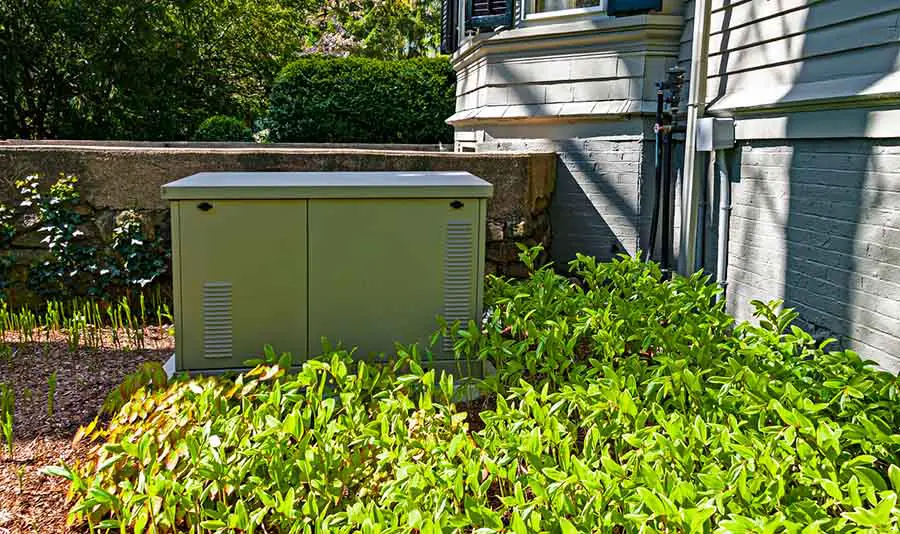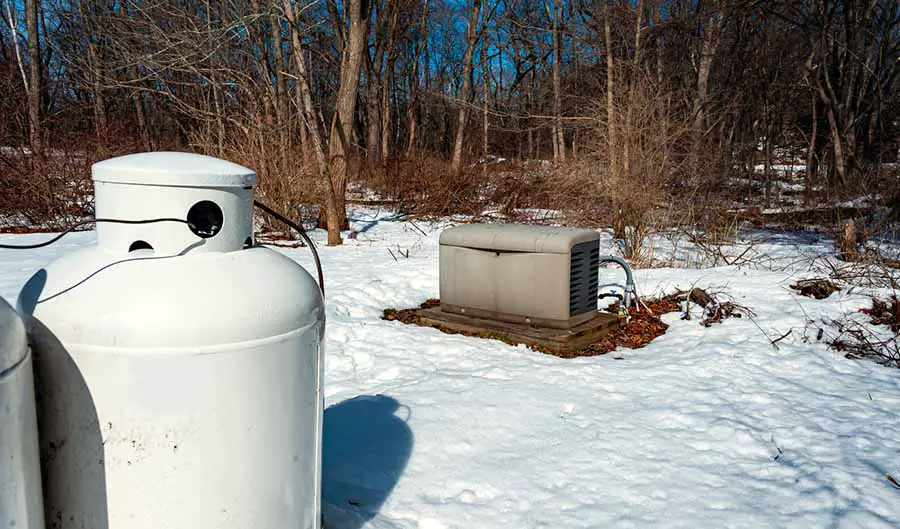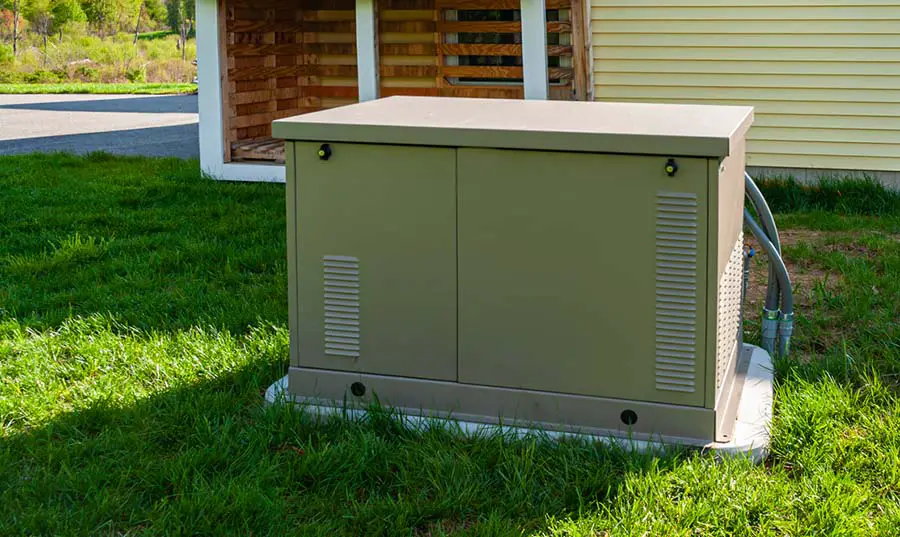
You have bought your small portable generator, or maybe a large permanent one, that now needs to be installed and hooked up to everything. This is a simple idea in theory, but once you read all the needs, it can suddenly become a lot more confusing as to which spots will work the best.
You must install generators in well-ventilated areas at least 20 feet away from your home. Near your garage, garden shed, in an unused corner of the yard, or on a concrete pad are all good spots for installing a generator. Ensure the fumes can dissipate in the air without accumulating in low areas.
These are just the basics of things you need to have and think about when installing your generator. Many first-time generator owners mistakenly believe that there is little to no danger in owning one, with a remarkable amount of people assuming even handheld portable generators are acceptable to run inside their homes.
What Are Some of The Best Locations for a Generator?
There are already several known locations around any house that we know are perfect for generators, each with its advantages or disadvantages. You need to be aware of each one before wasting your time stressing about whether or not you can install a generator at home.
Here are some of the best places to install a generator at your home:
- Outside the garage
- Near the garden shed
- In an unused corner of the lawn
- In a dedicated space or on a concrete pad
Even the smallest homes have perfect locations for generators, usually in a way that homeowners would never have thought could be used for the machine. We have seen generators installed in some of the most unexpected locations, and they blend perfectly into the lawn in done right.
1. Outside the Garage
This is possibly the most used location as it allows you to have the generator close to an outlet comfortably and uses a minimal amount of space. The garage also gives enough buffering between where people are living and where the generator will be running.
Your generator will need a custom cover to keep it safe as it will still be outside in the wind and rain, with most new generators having housings that you can purchase. Installers of generators in your area will usually know the regulations and the best location to install your machine.
2. Near the Garden Shed
You cannot install and use the generator inside the garden shed, but you can build a housing attached to the shed that only houses the generator. This keeps it away from the house, provides easy access when needed, and means that you can easily use the generator when needed.
It’s important to note that you will have to connect the generator to a proper power port with either an underground or suspended cable. The power ports inside a garden shed are rarely solid and stable enough to support the current levels that you’ll draw.
3. Unused Corners of the Lawn
Not too far away from your house but far enough away so that the machine will not be in the way; this is when you usually see the generator in a plastic housing. Many mistake it for some pump for irrigation when it is the permanent home you have built for the generator.
It is always best to have the cable underground and purchase housing specially built by the manufacturer. An adequately covered generator in the garden will offer little danger to anyone and will be the least likely to cause any health problems to those living with it.
4. Building a Dedicated Space
This is only needed when your state requires it; you may have to build a dedicated concrete block to build the housing for your generator. Usually, these need to be made by professionals who can get the proper certifications once finished.
Many places limit what defines a portable generator, requiring you to install anything above a certain power level permanently. This decreases the overall deaths because of CO2 poisoning but does require that you pay more to have a suitably strong generator installed.
What Are The Requirements of a Good Generator Location?

There are several that all good generator locations have; each is vital to ensuring that your generator stays clean and safe. Many people assume that the generator can be placed in a random spot around the house and left to do its thing, rain or sun.
However, you must know what you need from the best locations you have chosen and why they are essential. The generator’s placement is often more complicated than actually selecting the best generator for your house; once installed, it can be expensive to move it.
Ventilation Is Important
Your generator will produce one other thing besides energy, which is deadly CO2-heavy exhaust fumes. Your generator’s location should have a good and constant fresh air flow, either through wind or just being completely open.
CO2 gas is one of the deadliest gases globally, simply because it has no natural odor, and you don’t know that you are being poisoned until it is too late. We highly recommend that you ensure that all exhaust fumes from the generator can dissipate into nothingness at all times.
Ease of Access Is a Must
Your generator won’t need repairs or anything of the kind for the first few months that you are running it; however, it needs new oil once it reaches 200 hours. If you have placed the generator in the corner against a wall, you will quickly find a problem getting to everything.
Your generator must be easily accessible from all sides to ensure that you can quickly and comfortably reach each part of the machine to service it properly. Many people leave generators to run without proper care simply because they were placed in locations that make it impossible to reach every part of it.
Within Local Regulations
Every country on earth has different regulations for their generator locations, and in many cases, it will also differ from state to state. You must ensure that your chosen location is well within the given regulations, or you may receive a fine.
These regulations can usually be found online from your local government’s website, with some saying generators have to be at least 20 feet away from home. However, some countries say the generator cannot be close to a bedroom, making things extremely confusing when installing.
How To See If a Space Will Work for Your Generator?

Now that you know why a specific location is needed, you will need to recognize or create the basics for a generator spot. Often, the people unaware of their generators’ dangers will place them where it is convenient instead of what it needs to be.
You will need to check on several things before simply installing your generator; each one of these is essential to remember when placing your machine. It may seem like simple things, but many times people make the mistake of not ensuring each one has been done correctly, causing problems later on.
Away From Your Home
Your generator needs to be installed as far away from your house as possible while still having a power cable connected to it that is not too long. The golden zone is between 20 to 30 feet away from the main house you live in, with locations such as just outside the garage usually being best.
Often, people will have large houses but not large lawns that would allow them to place the generator far enough away, which is why putting other rooms in the way may be acceptable. The generator can be against the far wall of an attached two-car garage in many situations.
Flat Areas
A generator cannot run long when in a slanted position; the four-stroke engine inside all of these machines needs a level to be properly oiled. As the engine runs, some hooks catch oil; if the oil inside is not level, these hooks will not always reach the oil, causing damage.
While some of the smaller portable generators can work in any amount of slant, the same cannot be said for larger generators. While some slant is acceptable, anything that makes the machine visibly slanted will cause both the oil and fuel delivery inside the engine to be wrong.
No Grassy, Sandy, or Muddy Areas
While it is beautiful placing the generator down on a grassy or sandy area, it should only be for a short while if you need some quick energy. These areas will introduce sand, mud, and bugs to the generator that will cause damage as the filters become clogged.
If you cannot place the generator on a paved area with a roof, we recommend building it a custom enclosure, with its air intake at the top and the exhaust near the bottom. This will protect and keep the generator a lot cleaner for a lot longer as it will not be exposed to the elements.
Nowhere Near People
As the generator will constantly be expelling exhaust fumes, it is best to ensure that no one will be exposed to these for longer than a few minutes. The location you are looking for should preferably be away from any spot that people would gather, sit and relax, or sleep.
This is why you will find some beautiful and unique generators closed and covered almost on the opposite side of a house. Most homeowners have a storage location or covered area that they use to store unwanted materials; it is here that they also install their generators.
How Does Running the Generator Affect Its Location?
The generator will be extremely loud as it is an engine that is being run constantly, with the immediate area having a strong smell of exhaust fumes. If it is a more significant generator, the machine will also heat the surrounding area, possibly melting any plastics that are not correctly rated.
This is why you cannot simply build a wood cage around your generator, nor can you build a cover out of materials that cannot withstand high temperatures. You must ensure that whichever way you cover the generator is appropriately rated to handle temperatures reaching 100 degrees Celsius.
Apart from this, the generator will have minimal effect on its surrounding area as it is a contained system that should not leak any fluids. As the machine ages, it may be needed to trim the surrounding plants away from the system to ensure no unwanted plant growth.
Why Should You Never Run a Generator Inside a Building?
A running generator will produce a large amount of CO2 gas; when placed inside an enclosed space, it will quickly convert the oxygen into multiple gases. These gasses stay close to the ground and will start poisoning you in a matter of minutes if you inhale them.
It is estimated that over 900 people died between 2005 and 2017 from CO2 poisoning, which is a lot more than it should be when you consider how hard this is to do. Most people can be okay within a few hours after getting CO2 poisoning once they are away from the area with the toxic gasses.
Usually, people who die of CO2 poisoning or are seriously hurt must be exposed to a high concentration or a more extended amount of time. This is why you should never fall asleep if you suspect that you are undergoing a lack of oxygen instead of making every attempt to get fresh air.
What Types of Generators Are Run Inside Buildings?
No gas-powered generator will be safe to run inside a building; the only generator systems that have components inside a house are battery generators. These systems rely on solar or wind energy to produce power and then store that power inside batteries.
A small leak in your gas-powered generator can become a quick and deadly problem no matter how well you have planned for the situation. Battery-powered systems will not affect the breathable air inside of your home but will still be required not to be in your immediate living space.
If you have seen generators running inside a building, these are usually extensive systems, and the facility they are in has been purpose-built for this function. Some of the largest generators in the world are several times the size of an average car and can deliver power to entire countries.
Conclusion
The location of your generator is one of the essential parts of its smooth and problem-free operation. If you are unsure about every step that needs to be taken, it may be well worth it to hire a professional that is aware of all the rules and regulations in your area.
Whatever you do, please don’t think that a portable generator is any less dangerous than a permanent one!
